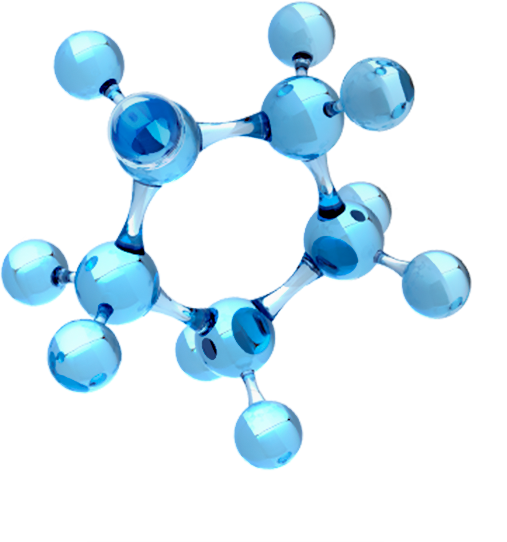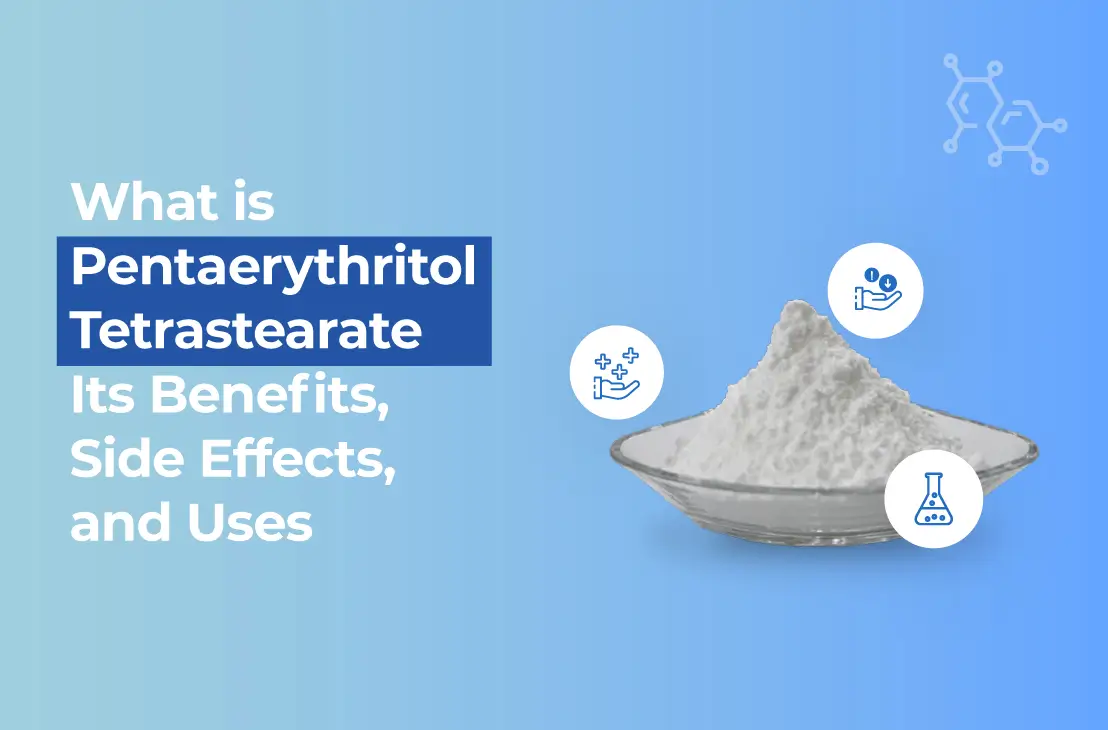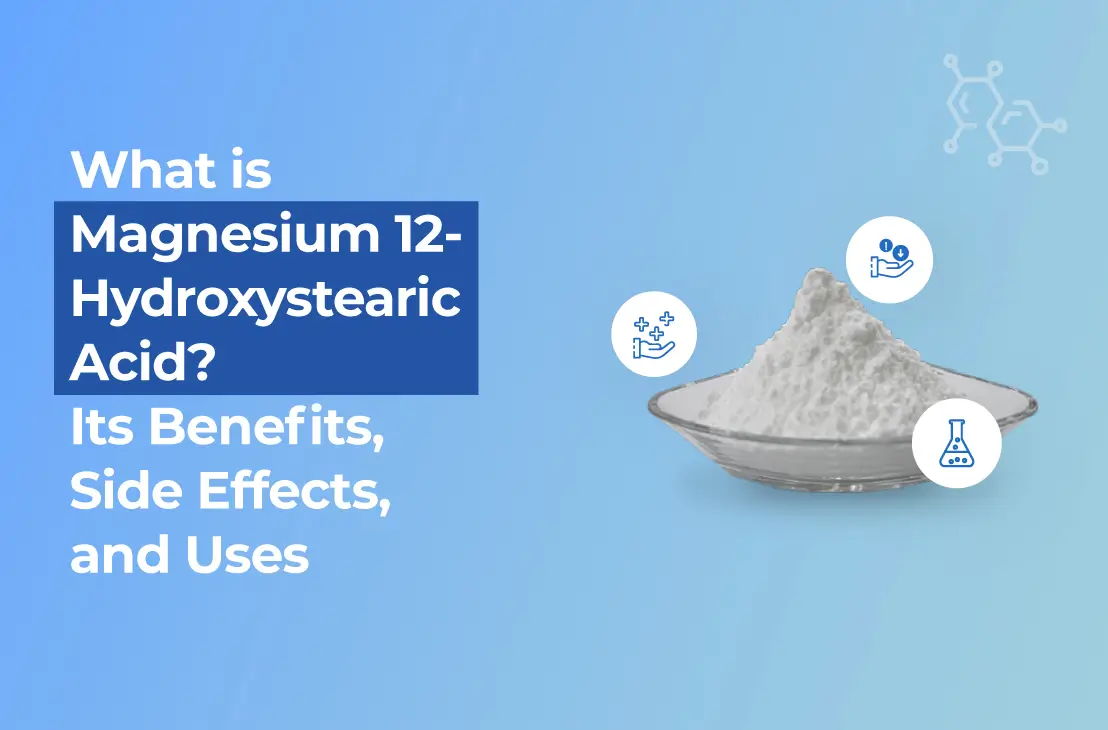Calcium 12-Hydroxystearic Acid (Ca12HSA) is a versatile chemical compound used in a wide range of industries, from plastics and stabilizers to lubricants and personal care products. Its unique properties have made it a critical ingredient in many formulations. Understanding its structure, benefits, side effects, and uses can provide valuable insights for manufacturers and consumers alike. This blog will dive deep into the world of Calcium 12-Hydroxystearic Acid, exploring its chemical composition, diverse benefits, potential side effects, and applications in various sectors.
What is Calcium 12-Hydroxystearic Acid?
Calcium 12-Hydroxystearic Acid is a calcium salt of 12-hydroxystearic acid, a fatty acid derived from the hydrogenation of castor oil. The name itself can be broken down into its components: calcium refers to the metal ion, 12-hydroxy points to the hydroxyl group (OH) located at the 12th carbon of the stearic acid chain, and stearic acid is a long-chain fatty acid with 18 carbon atoms.
The compound is often produced as a white, waxy powder or a solid material. It’s primarily used as a stabilizer and lubricant, owing to its chemical structure, which allows it to act as a dispersing agent in various formulations.
What is Calcium 12-Hydroxystearic Acid?
Calcium 12-Hydroxystearic Acid is a calcium salt of 12-hydroxystearic acid, a fatty acid derived from the hydrogenation of castor oil. The name itself can be broken down into its components: calcium refers to the metal ion, 12-hydroxy points to the hydroxyl group (OH) located at the 12th carbon of the stearic acid chain, and stearic acid is a long-chain fatty acid with 18 carbon atoms.
The compound is often produced as a white, waxy powder or a solid material. It’s primarily used as a stabilizer and lubricant, owing to its chemical structure, which allows it to act as a dispersing agent in various formulations.
Chemical Structure and Properties
The structure of Calcium 12-Hydroxystearic Acid consists of a long hydrocarbon chain with a hydroxyl group attached to the 12th carbon atom. This unique structure enables it to form stable complexes with metal ions like calcium. It’s highly lipophilic (fat-loving), meaning it readily dissolves in fats and oils, but is only sparingly soluble in water.
The calcium ion in its composition enhances its ability to act as a stabilizer for polymer formulations, particularly in applications involving high temperatures and exposure to ultraviolet light. This property makes it an effective compound for industries requiring durable and stable products.
Benefits of Calcium 12-Hydroxystearic Acid
-
Excellent Stabilizing Properties
Calcium 12-Hydroxystearic Acid is best known for its role as a stabilizer in the production of various materials, particularly in the plastic industry. It’s commonly used in PVC (polyvinyl chloride) and other polymer formulations to improve the heat stability of the product. By preventing degradation during high-temperature processes, Ca12HSA ensures that the final product retains its desired properties for a longer time.
-
Lubrication and Release Agent
Due to its fatty acid structure, Calcium 12-Hydroxystearic Acid acts as a lubricant and release agent in numerous applications. It's used in manufacturing processes like injection molding and extrusion, where smooth movement of materials is required. Its lubricating properties help reduce friction, improving efficiency during production.
Additionally, Calcium 12-Hydroxystearic Acid enhances the surface finish of molded products, preventing sticking to molds and dies. This makes it especially useful in industries dealing with metals, plastics, and rubber.
-
Compatibility with Various Materials
Ca12HSA is compatible with a wide range of materials, including natural and synthetic resins, oils, and waxes. This broad compatibility makes it a go-to choice for a wide array of industrial applications. In coatings, paints, and inks, it ensures uniform dispersion of pigments and fillers, contributing to high-quality finishes.
-
Enhancement of Mechanical Properties
Calcium 12-Hydroxystearic Acid also improves the mechanical properties of materials in which it is used. In plastic formulations, it helps in increasing the tensile strength, impact resistance, and flexibility of the final product. This is particularly beneficial for applications where the material is exposed to wear and tear or environmental stress.
-
Use in Cosmetics and Personal Care
The chemical is widely used in the cosmetic and personal care industry, where it acts as an emulsifier, stabilizer, and thickener. It helps in maintaining the texture and consistency of products like creams, lotions, deodorants, and sunscreens. By providing a smooth texture and ensuring that ingredients stay properly mixed, Calcium 12-Hydroxystearic Acid plays an essential role in formulating effective personal care products.
-
Biodegradable and Eco-friendly
One of the key benefits of Calcium 12-Hydroxystearic Acid is its biodegradability. It is derived from natural sources and breaks down relatively quickly in the environment. This makes it a more eco-friendly alternative compared to some other synthetic stabilizers, which can persist in the environment for longer periods.
Uses of Calcium 12-Hydroxystearic Acid
-
Polymer Industry
The polymer industry is one of the largest users of Calcium 12-Hydroxystearic Acid. It is commonly used as a stabilizer in the production of PVC and other plastics. The compound helps in preventing discoloration, degradation, and loss of strength during the manufacturing process. By improving heat stability, it ensures that plastic products maintain their integrity under high-temperature conditions.
-
Lubricants and Greases
In the manufacturing of lubricants and greases, Calcium 12-Hydroxystearic Acid acts as a thickening agent. It increases the viscosity of lubricating oils, making them more effective in reducing friction between moving parts. This is particularly important in automotive, industrial machinery, and manufacturing applications, where efficient lubrication can lead to longer-lasting equipment and improved performance.
-
Rubber Industry
The rubber industry also benefits from the use of Calcium 12-Hydroxystearic Acid. It serves as an additive in rubber formulations, improving the processing of the material. The compound helps in dispersing fillers and enhancing the vulcanization process, leading to stronger and more durable rubber products.
-
Paints and Coatings
In paints, coatings, and inks, Calcium 12-Hydroxystearic Acid plays an essential role in ensuring smooth application and consistency. It helps in dispersing pigments and preventing settling. It also aids in the adhesion of the coating to surfaces and improves the finish by providing better leveling properties.
-
Cosmetics and Personal Care
In cosmetics, Calcium 12-Hydroxystearic Acid is used in the formulation of creams, lotions, shampoos, and other personal care products. It functions as an emulsifier to help blend water and oil-based ingredients. Its stabilizing properties prevent the separation of ingredients, ensuring that the product remains smooth and homogeneous throughout its shelf life.
-
Food Industry
Although not as common, Calcium 12-Hydroxystearic Acid finds limited use in the food industry as a stabilizer in food packaging and as a coating agent for processed foods. It helps in improving the shelf life and preserving the quality of food items, especially in terms of their appearance and texture.
Side Effects of Calcium 12-Hydroxystearic Acid
While Potassium Stearate is generally considered safe for use, certain precautions should be observed to avoid potential side effects:Although Calcium 12-Hydroxystearic Acid is generally considered safe and non-toxic, there are some considerations and potential side effects when it is used improperly or in excessive quantities.
-
Skin Irritation
In the cosmetic and personal care industry, Calcium 12-Hydroxystearic Acid is widely regarded as safe for topical use. However, individuals with sensitive skin may experience mild irritation or allergic reactions when using products containing this compound. It’s always advisable to patch-test a small amount of the product on the skin before full application.
-
Eye Irritation
Like many other chemicals used in the cosmetics industry, Calcium 12-Hydroxystearic Acid can cause irritation if it comes into contact with the eyes. If accidental exposure occurs, it's recommended to flush the eyes with water immediately.
-
Environmental Impact
While Calcium 12-Hydroxystearic Acid is biodegradable and more eco-friendly than many synthetic stabilizers, the excessive accumulation of calcium compounds in the environment could potentially lead to soil and water contamination. This is especially a concern if large quantities are improperly disposed of during industrial processes.
-
Respiratory Issues
Inhalation of dust or fumes from Calcium 12-Hydroxystearic Acid during manufacturing or processing can lead to respiratory discomfort or irritation. This is a risk in industrial settings, and adequate ventilation and personal protective equipment (PPE) should be used.
Conclusion
Calcium 12-Hydroxystearic Acid is an indispensable compound in various industries due to its stabilizing, lubricating, and emulsifying properties. It offers numerous benefits, including enhanced material durability, improved mechanical properties, and better environmental compatibility. From the polymer and rubber industries to cosmetics and personal care, this compound plays a critical role in producing high-quality, long-lasting products.
While it has minimal side effects, proper handling and use are essential to avoid any potential issues. Whether you're a manufacturer or a consumer, understanding Calcium 12-Hydroxystearic Acid’s applications and effects can help in making informed decisions when choosing materials and products for your needs.
As a manufacturer, Nimbasia Stabilizers produces high-quality Calcium 12-Hydroxystearic Acid, ensuring that industries can rely on it for their most demanding applications.









